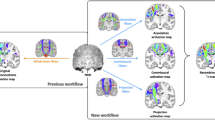Abstract
The aim of this work is to develop method of functional tractography based on the fast MRI sequence (Multi-Band EPI). It is planned to identify active areas of white matter (active tracts) responsible for the realization of motor function and visual perception. The functional MRI method, universally recognized and quite popular in cognitive brain studies, clearly reveals sources of activity in the gray matter of the brain. Proposed method of functional tractography supposed to make it possible to determine the activity in the deep structures of white matter tracts, which gives a number of advantages in understanding the network interaction of human brain regions among themselves both in healthy people and in patients.
Access this chapter
Tax calculation will be finalised at checkout
Purchases are for personal use only
Similar content being viewed by others
References
Sharaev, M., Ushakov, V., Velichkovsky, B.: Causal interactions within the default mode network as revealed by low-frequency brain fluctuations and information transfer entropy. In: Samsonovich, A., Klimov, V., Rybina, G. (eds.) Biologically Inspired Cognitive Architectures (BICA) for Young Scientists. Advances in Intelligent Systems and Computing, vol. 449, pp. 213–218. Springer, Cham (2016). https://doi.org/10.1007/978-3-319-32554-5_27
Rubinov, M., Sporns, O.: Complex network measures of brain connectivity: uses and interpretations. NeuroImage 53(3), 1059–1069 (2010)
Tirosh, N., Nevo, U.: Neuronal activity significantly reduces water displacement: DWI of a vital rat spinal cord with no hemodynamic effect. Neuroimage 76, 98–107 (2013)
Mandl, R., Schnack, H., Zwiers, M., Kahn, R., Pol, H.: Functional diffusion tensor imaging at 3 Tesla. Front. Hum. Neurosci. 1–9 (2013)
Kartashov, S., Ushakov, V., Maslennikova, A., Velichkovsky, B.: Human brain structural organization in healthy volunteers and patients with schizophrenia. In: Biologically Inspired Cognitive Architectures (BICA) for Young Scientists. Proceedings of the First International Early Research Career Enhancement School on BICA and Cybersecurity (FIERCES 2017). Advances in Intelligent Systems and Computing, vol. 636, pp. 85–90 (2017)
Ushakov, V.L., Samsonovich, A.V.: Toward a BICA-model-based study of cognition using brain imaging techniques. Procedia Comput. Sci. 71, 254–264 (2015)
Arinchekhina, J.A., Orlov, V.A., Samsonovich, A.V., Ushakov, V.L.: Comparative study of semantic mapping of images. Procedia Comput. Sci. 123, 47–56 (2018)
Acknowledgements
This work was in part supported by the Russian Science Foundation, Grant № 18-11-00336 (data preprocessing algorithms) and by the Russian Foundation for Basic Research grants ofi-m 17-29-02518 (study of thinking levels) and 18-315-00304 (studying of structural connections by diffusion MRI).
The authors are grateful to the MEPhI Academic Excellence Project for providing computing resources and facilities to perform experimental data processing.
Author information
Authors and Affiliations
Corresponding author
Editor information
Editors and Affiliations
Rights and permissions
Copyright information
© 2019 Springer Nature Switzerland AG
About this paper
Cite this paper
Kartashov, S., Ponomarenko, N., Ushakov, V. (2019). The Concept of Functional Tractography Method for Cognitive Brain Studies. In: Samsonovich, A. (eds) Biologically Inspired Cognitive Architectures 2018. BICA 2018. Advances in Intelligent Systems and Computing, vol 848. Springer, Cham. https://doi.org/10.1007/978-3-319-99316-4_21
Download citation
DOI: https://doi.org/10.1007/978-3-319-99316-4_21
Published:
Publisher Name: Springer, Cham
Print ISBN: 978-3-319-99315-7
Online ISBN: 978-3-319-99316-4
eBook Packages: Intelligent Technologies and RoboticsIntelligent Technologies and Robotics (R0)




